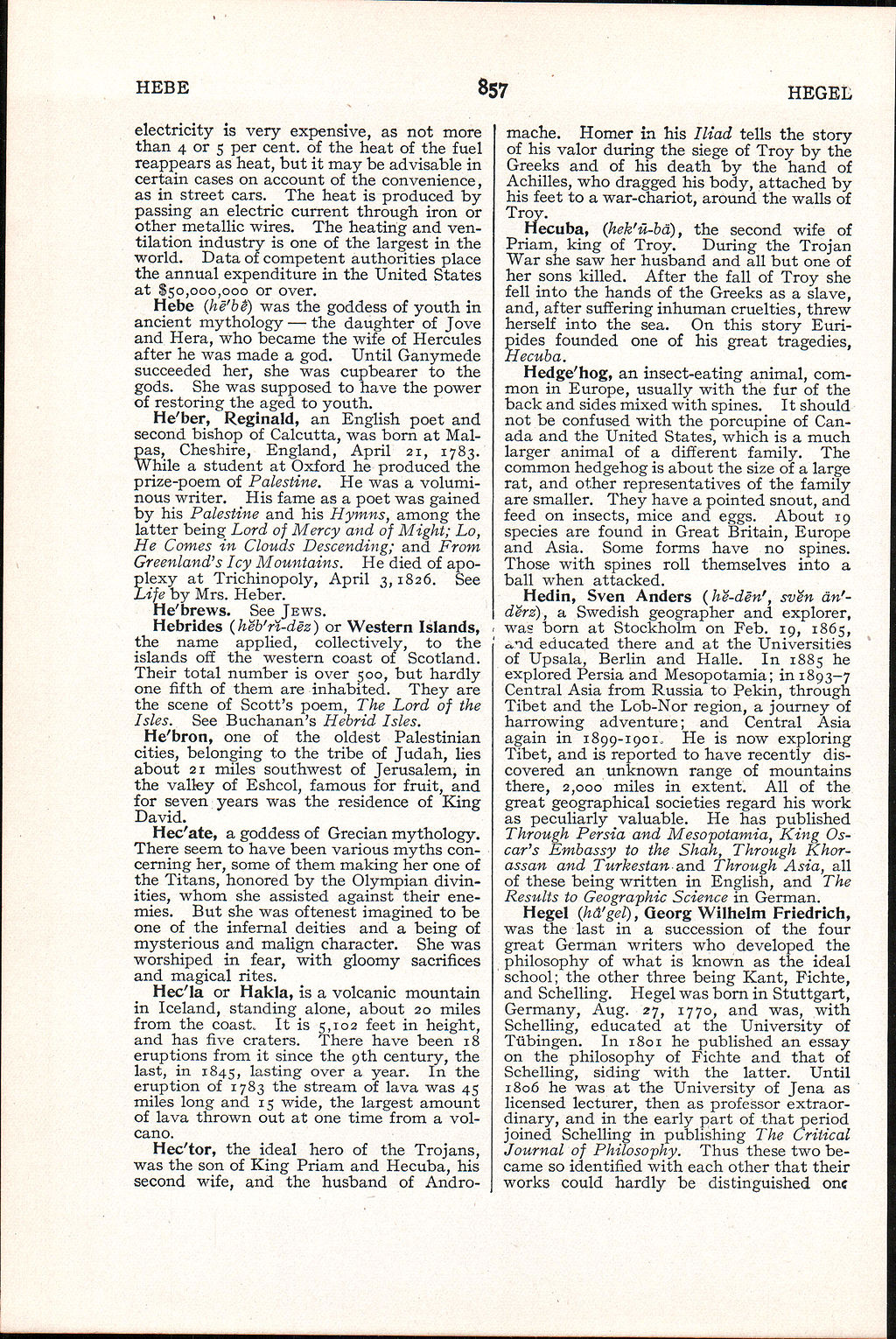HEBE
857
HEGEL
electricity is very expensive, as not more than 4 or 5 per cent, of the heat of the fuel reappears as heat, but it may be advisable in certain cases on account of the convenience, as in street cars. The heat is produced by passing an electric current through iron or other metallic wires. The heating and ventilation industry is one of the largest in the world. Data of competent authorities place the annual expenditure in the United States at $50,000,000 or over.
Hebe (he'be) was the goddess of youth in ancient mythology — the daughter of Jove and Hera, who became the wife of Hercules after he was made a god. Until Ganymede succeeded her, she was cupbearer to the gods. She was supposed to have the power of restoring the aged to youth.
He'ber, Reginald, an English poet and second bishop of Calcutta, was born at Mai-pas, Cheshire, England, April 21, 1783. While a student at Oxford he produced the prize-poem of Palestine, He was a voluminous writer. His fame as a poet was gained by his Palestine and his Hymns, among the latter being Lord of Mercy and of Might; Lo, He Comes in Clouds Descending; and From Greenland's Icy Mountains. He died of apo-
£lexy at Trichinopoly, April 3,1826. See ife by Mrs. Heber.
He'brews. See JEWS.
Hebrides (heb'ri-dez) or Western Islands, the name applied, collectively, to the islands off the western coast of Scotland. Their total number is over 500, but hardly one fifth of them are inhabited. They are the scene of Scott's poem, The Lord of the Isles. See Buchanan's Hebrid Isles.
He'bron, one of the oldest Palestinian cities, belonging to the tribe of Judah, lies about 21 miles southwest of Jerusalem, in the valley of Eshcol, famous for fruit, and for seven years was the residence of King David.
Hec'ate, a goddess of Grecian mythology. There seem to have been various myths concerning her, some of them making her one of the Titans, honored by the Olympian divinities, whom she assisted against their enemies. But she was oftenest imagined to be one of the infernal deities and a being of mysterious and malign character. She was worshiped in fear, with gloomy sacrifices and magical rites.
Hec'la or Hakla, is a volcanic mountain in Iceland, standing alone, about 20 miles from the coast. It is 5,102 feet in height, and has five craters. There have been 18 eruptions from it since the pth century, the last, in 1845, lasting over a year. In the eruption of 1783 the stream of lava was 45 miles long and 15 wide, the largest amount of lava thrown out at one time from a volcano.
Hec'tor, the ideal hero of the Trojans, was the son of King Priam and Hecuba, his second wife, and the husband of Andro-
mache. Homer in his Iliad tells the story of his valor during the siege of Troy by the Greeks and of his death by the hand of Achilles, who dragged his body, attached by his feet to a war-chariot, around the walls of Troy.
Hecuba, (hekʹū-bä), the second wife of Priam, king of Troy. During the Trojan War she saw her husband and all but one of her sons killed. After the fall of Troy she fell into the hands of the Greeks as a slave, and, after suffering inhuman cruelties, threw herself into the sea. On this story Euripides founded one of his great tragedies, Hecuba.
Hedge'hog, an insect-eating animal, common in Europe, usually with the fur of the back and sides mixed with spines. It should not be confused with the porcupine of Canada and the United States, which is a much larger animal of a different family. The common hedgehog is about the size of a large rat, and other representatives of the family are smaller. They have a pointed snout, and feed on insects, mice and eggs. About 19 species are found in Great Britain, Europe and Asia. Some forms have no spines. Those with spines roll themselves into a ball when attacked.
Hedin, Sven Anders (he-den', sven anr-derz), a Swedish geographer and explorer, was born at Stockholm on Feb. 19, 1865, ^nd educated there and at the Universities of Upsala, Berlin and Halle. In 1885 he explored Persia and Mesopotamia; in 1893-7 Central Asia from Russia to Pekin, through Tibet and the Lob-Nor region, a journey of harrowing adventure; and Central Asia again in 1899-190X0 He is now exploring Tibet, and is reported to have recently discovered an unknown range of mountains there, 2,000 miles in extent. All of the great geographical societies regard his work as peculiarly valuable. He has published Through Persia and Mesopotamia, King Oscar's Embassy to the Shah, Through Khor-assan and Turkestan and Through Asia, all of these being written in English, and The Results to Geographic Science in German.
Hegel (ha!gel), Qeorg Wilhelm Friedrich, was the last in a succession of the four great German writers who developed the philosophy of what is known as the ideal school; the other three being Kant, Fichte, and Schelling. Hegel was born in Stuttgart, Germany, Aug. 27, 1770, and was, with Schelling, educated at the University of Tiibingen. In 1801 he published an essay on the philosophy of Fichte and that of Schelling, siding with the latter. Until 1806 he was at the University of Jena as licensed lecturer, then as professor extraordinary, and in the early part of that period joined Schelling in publishing The Critical Journal of Philosophy. Thus these two became so identified with each other that their works could hardly be distinguished one
